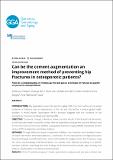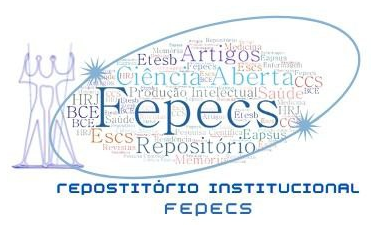Use este identificador para citar ou linkar para este item:
https://repositoriobce.fepecs.edu.br/handle/prefix/114Registro completo de metadados
| Campo DC | Valor | Idioma |
|---|---|---|
| dc.creator | Freitas, Anderson | - |
| dc.creator | Neri, George | - |
| dc.creator | Macedo Neto, Silvio Leite de | - |
| dc.creator | Borges, João Lindolfo Cunha | - |
| dc.creator | Paula, Ana Patrícia de | - |
| dc.date.accessioned | 2020-02-19T18:21:26Z | - |
| dc.date.available | 2020-02-26 | - |
| dc.date.available | 2020-02-19T18:21:26Z | - |
| dc.date.issued | 2016-11-08 | - |
| dc.identifier.citation | FREITAS, A., NERI, G., MACEDO NETO, S. L., BORGES, J. L.C., PAULA, A. P. Can be the cement augmentation an improvement method of preventing hip fractures in osteoporotic patients?. Geriatr Gerontol Aging. v. 11, n.1, p. 42-47. 2017. Disponível em: http://www.ggaging.com/details/416/en-US/can-be-the-cement-augmentation-an-improvement-method-of-preventing-hip-fractures-in-osteoporotic-patients-. Acesso em: 19 fev. 2020. | pt_BR |
| dc.citation.volume | 11 | pt_BR |
| dc.citation.issue | 1 | pt_BR |
| dc.identifier.uri | https://repositorio.fepecs.edu.br:8443/handle/prefix/114 | - |
| dc.description.abstract | INTRODUCTION: The population around the world is aging. With this, there will be an increased incidence of fractures due to osteoporosis of the hip and this will be a serious global health problem. A World Health Organization (WHO) estimate suggests that the incidence of hip osteoporotic fractures worldwide will triple by 2050. OBJECTIVE: To present, through a literature review, the main results of the femoral reinforcement, a technique described by scientific articles, with the potential to increase the proximal femoral load for the occurrence of fractures, whether using polymethylmethacrylate (PMMA), phosphate cement calcium (CPC), (j elastomers and metal implants. METHODS: Through electronic search in databases PubMed, Latin American and Caribbean Center of Health Information Information (Bireme), Coordination for the Improvement of Higher Education Personnel (Capes), Scientific Electronic Library Online (SciELO), Google Scholar And Cochrane, using the terms cementoplasty and femororplasty, the studies were selected according to a specific inclusion criterion, describing the main findings of the biomechanical results, type of study and material used to perform the femoral reinforcement. RESULTS: Of the 15 articles analyzed, 14 were experimental analyzes and one was a clinical trial, seven studies used PMMA, two used CPC, four elastomers and two metal implants, 13 of them showed favorable Newton load (N) results for the fracture hip. CONCLUSION: Most of the studies on femoral reinforcement is experimental, and mostly used the PMMA, presenting an increase in the load in N for fracture occurrence. | pt_BR |
| dc.description.resumo | INTRODUÇÃO: A população em todo o mundo está envelhecendo. Com isso, haverá aumento da incidência de fraturas por osteoporose do quadril e esse será um grave problema de saúde mundial. Uma previsão da Organização Mundial de Saúde (OMS) mostra que a incidência de fraturas osteoporóticas do quadril em todo o mundo triplicará até o ano 2050. OBJETIVO: Apresentar por meio de revisão da literatura os principais resultados do reforço femoral, técnica descrita por artigos científicos, com potencial de incrementar a carga do fêmur proximal para a ocorrência de fraturas, seja com uso de polimetilmetacrilato (PMMA), cimento fosfato de cálcio (CPC), elastômeros ou implantes metálicos. MÉTODOS: Por meio de busca eletrônica nas bases de dados PubMed, Latin American and Caribbean Center of Health Science Information (Bireme), Coordination for the Improvement of Higher Education Personnel (Capes), Scientific Electronic Library Online (SciELO), Google Scholar and Cochrane, utilizando os termos Cementoplasty e femororplasty, foram selecionados os trabalhos respeitando um critério de inclusão específico, descrevendo os principais achados dos resultados biomecânicos, o tipo de estudo e o material utilizado na realização do reforço femoral. RESULTADOS: Dos 15 artigos analisados, 14 são análises experimentais e um é ensaio clínico, sete estudos utilizaram PMMA, dois usaram CPC, quatro elastômeros e dois implantes metálicos, 13 deles mostram resultados favoráveis na carga em Newton (N) para a ocorrência da fratura do quadril. CONCLUSÃO: A maioria dos estudos sobre reforço femoral é experimental e em sua maioria utilizou o PMMA, apresentando incremento da carga em N para a ocorrência de fratura. | pt_BR |
| dc.language | eng | pt_BR |
| dc.publisher.country | Brasil | pt_BR |
| dc.publisher.initials | FEPECS | pt_BR |
| dc.relation.ispartof | Geriatrics, Gerontology and Aging | pt_BR |
| dc.rights | Acesso Aberto | pt_BR |
| dc.subject | Polimetil metacrilato | pt_BR |
| dc.subject | Fraturas do quadril | pt_BR |
| dc.subject | Osteoporose | pt_BR |
| dc.subject | Quadril | pt_BR |
| dc.subject.cnpq | CNPQ::CIENCIAS DA SAUDE::MEDICINA::CIRURGIA | pt_BR |
| dc.title | Can be the cement augmentation an improvement method of preventing hip fractures in osteoporotic patients? | pt_BR |
| dc.title.alternative | Pode ser a cimentoplastia um método aprimorado para a prevenção de fraturas do quadril em pacientes osteoporóticos? | pt_BR |
| dc.type | Artigo de Periódico | pt_BR |
| dc.rights.license | Geriatrics, Gerontology and Aging is an open access publication, that is, the journal provides free access to the published research, at no cost to users or institutions. Users are allowed to read, download, copy, distribute, print, search, and link the full-text articles or to use them for individual non-commercial purposes without the need for prior permission from the editor or authors. | - |
| Aparece nas coleções: | Artigos publicados em periódicos - MP | |
Arquivos associados a este item:
| Arquivo | Descrição | Tamanho | Formato | |
|---|---|---|---|---|
| Geriatrics, Gerontology and Aging.pdf | ARTIGO_Canbethecementaugmentationanimprovement | 254,68 kB | Adobe PDF |  Visualizar/Abrir |
Os itens no repositório estão protegidos por copyright, com todos os direitos reservados, salvo quando é indicado o contrário.

